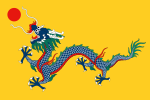Estandarte Azul Bordado
| Estandarte Azul Bordado | |
|---|---|

| |
| País | Dinastia Jin Posterior |
| Ramo | Oito Estandartes |
| Período de atividade | 1615–1912 |
| Comando | |
| Comandante | Príncipe Zheng |
O Estandarte Azul Bordado (chinês tradicional: 鑲藍旗, chinês simplificado: 镶蓝旗, pinyin: Xiāng Lán Qí) foi um dos Oito Estandartes do exército e da sociedade Manchu durante as dinastias Jin Posterior e Qing posteriores da China. Foi um dos cinco estandartes inferiores. De acordo com os anais gerais das Oito Estandartes, o Estandarte Azul Bordado era um dos estandartes localizadas na ala sul direita (os estandartes azuis estão localizadas ao sul, o Estandarte Azul Simples estando na ala sul esquerda). [1]
Este estandarte foi comandada pelo príncipe Zheng, da linhagem de Šurhaci e seu filho Jirgalang. Pelo sangue de seus comandantes, o Estandarte Azul Bordado era o estandarte mais remoto dos Oito Estandartes; já que todos os outros estandartes foram lideradas por descendentes de Nurhachi. [2] Devido ao seu estatuto genealógico, este estandarte era geralmente vista como o último estandarte dos Oito Estandartes, embora não existissem leis concretas para reconhecer oficialmente este estatuto.
Algumas partes dos Jurchéns Haixi foram incorporadas a este estandarte após a derrota dos Haixi pelos Jurchéns Jianzhou. [3]
Membros notáveis
[editar | editar código-fonte]- Imperatriz Viúva Cixi
- Imperatriz Nara
- Sushun de Aisin-Gioro
- Shang Kexi
- Duanhua
- Gu Tai Qing
- Šarhūda
- Nobre Consorte Imperial Xianzhe
- Nobre Consorte Yu
- Consorte Chang
- Nobre Consorte Imperial Dunhui
- Nobre Consorte Xun (Consorte do Imperador Qianlong)
Clãs notáveis
[editar | editar código-fonte]- Irgen Gioro
- Sirin Gioro
- Šušu Gioro
- Hešeri
- Clã Nara
- Gogiya
- Keliyete
- Shang
- Giorca
Referências
- ↑ General annals of the Eight Banners.vol 30
- ↑ Meng, Sen (2011). Notes on the history of the Ming and qing dynasties. [S.l.]: 商务印书馆. ISBN 9787100074650
- ↑ General annals of the Eight Banners.vol 16
Bibliografia
[editar | editar código-fonte]- Elliott, Mark C. (2001), The Manchu Way: The Eight Banners and Ethnic Identity in Late Imperial China, ISBN 9780804746847, Stanford University Press
- Wakeman Jr., Frederic (1985), The Great Enterprise: The Manchu Reconstruction of Imperial Order in Seventeenth-century China, ISBN 0520048040, Berkeley: University of California Press
Leitura adicional
[editar | editar código-fonte]- Dennerline, Jerry (2002), «The Shun-Chih Reign», in: Peterson, Willard J.; Twitchett, Denis Crispin; Fairbank, John King, The Cambridge History of China: Volume 9, Part 1, The Ch'ing Empire to 1800, ISBN 9780521243346, The Cambridge History of China, 9, Cambridge University Press
- Rawski, Evelyn S. (1998), The Last Emperors: A Social History of Qing Imperial Institutions, ISBN 9780520926790, University of California Press

